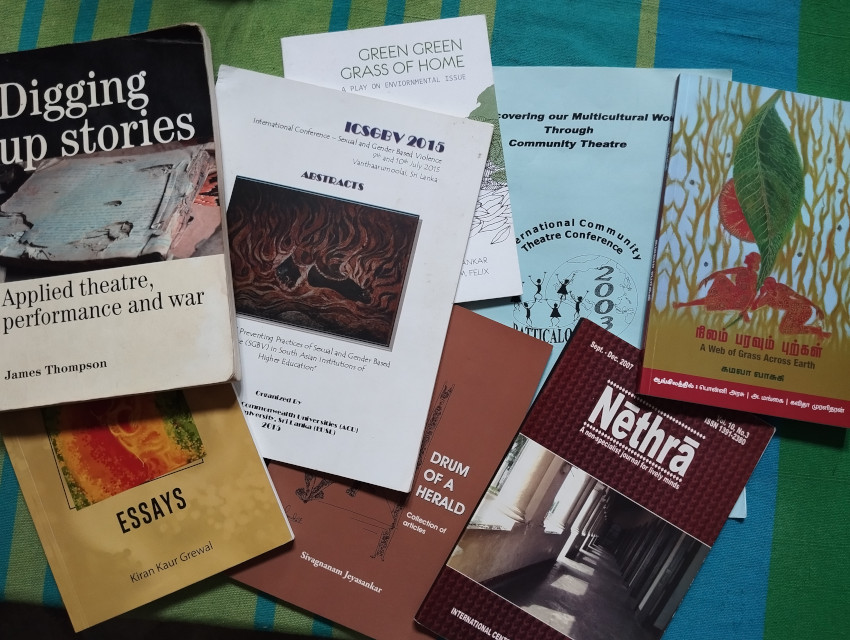Our recent discussions with Prof. Sivagnanam Jeyasankar from the Department of Fine Arts, Eastern University of Sri Lanka centred around poetry, performance, writings in Tamil, translations between Tamil and Sinhala, and building partnerships for better interaction and understanding. Above are some of the books and pamphlets that he shared with us at one of our meetings. Following are some areas we touched upon during our conversations these past two months.
In poetry, two very important figures are, C. V. Velupillai and the poet Thambimuththu. And another is T. Ramanathan from Up Country, maybe Kandy.
C. V. Velupillai, writing in English, was the pioneer in poetry. However, he is not mentioned in most of the accounts on writers written locally, and was not given due exposure.
Polinus Thambimuthu is a poet from Jaffna. He was away in England and once he returned he started working on a Sri Lankan anthology of poetry. I got to know of this from A. J. Canakaratne. However Thambimuthu passed away before this work was completed and it is not known what happened to this manuscript that he was compiling. (There is another Thambimuthu, Sam Thambimuthu, the politician from Batticaloa, who is a different person.)
There is a need to discuss some of these poets that have not received due prominence and also some poetry that have focused on issues not addressed in conventional spaces related to poetry.
At present, poems are being translated from Sinhala to Tamil. One writer is working on a paper related to this, and planning to do a collection. Another person is doing translations from English to Tamil. Around twelve translators of different age groups are continuously doing translations from Sinhala to Tamil. I am trying to bring together the youngsters interested in doing translations. The idea is to have a database of translators and writers.
On theatre in Batticaloa, Jeyasankar said:
Earlier we were told that these traditional theatres were not aesthetically advanced, that they were quite backward. But when I traveled to different places to gather some theatrical elements for our children’s theatre and modern theatre, during that journey I found that the language of traditional theatre is entirely different. In academic establishments Kooththu was thought of as dance and music and some spectacles that will cater for the creation of the modern theatre, but that theatre itself was perceived as rather low-standing. That is the standpoint of earlier academics. But when I traveled to different traditional theatres to watch, one of my friends said, “Kooththu is not simply dance and music. You have to perceive Kooththu with the community”. That is the key turning point for me. And he took me to different places to watch the Kooththu. People who interpret it with the modern theatre, simply get the performance aspect only. But in Kooththu, performance is one of the aspects. Selection of the cast is a ceremony. If a group of people decide that this year we are going to perform, then they inform the whole village. Then on a particular day they gather together and the cast selection will happen. Then they will practice in an open space. So these elderly people will come there and sit and kids will come there and play… In the Kooththu a mixed group will perform. Well experienced and newcomers. So the newcomers must master in the dance. If everything is okay, then they fix a date. It is a day-long programme. It’s a festival. After that they will fix the date for arangetram (ascending the stage)… Then after the arangetram, the next morning, they will perform at the temple for those who have supported the event, and for those who are not able to come to the venue, such as sick people, they will visit those places and perform. So Kooththu is a process. But the problem is, these people took only the performance, arangetram, and the whole community-based activity was forgotten because of modern perception.
Our conversations touched upon many aspects of performance and also on various different individual works of interest. We plan to expand on these discussions and also to connect up to work further on these areas of interest.

Leave a Reply